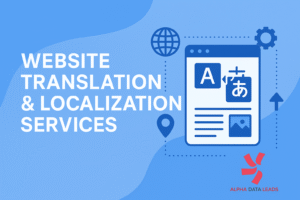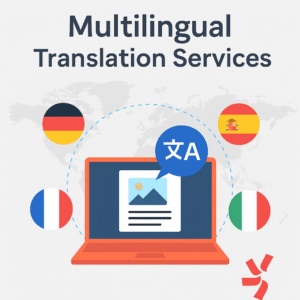Can you pronounce YouTube in Japanese? Do you know about the social media giant in China that eclipses Facebook? Reaching the top of search engine ranks might seem challenging enough in English, not in other languages. However, tailoring your website for multilingual consumers may reap significant benefits by capitalizing on expanding, and unexplored markets.
Non-English speakers are increasingly using the Internet. According to Internet World Stats, less than 27% of citizens speak English. Additionally, more than half of all search queries are in other languages.
From 2000 to 2011, Arabic internet users climbed by a stunning 2501.2%, whereas English internet users grew by just 301.4%. Moreover, studies suggest people are hesitant to buy things online if they cannot read about them in their local language.
Surprisingly, internet marketers have been hesitant to capitalize on this trend. While the most popular terms in English face fierce competition, this isn’t necessarily the case in other languages. Translating your website is a simple way to reach your audience. And because there is less competition, climbing the search engine ranks requires less effort.
This may appear to be a challenging task, and it may take some time to get it right. But, a bit of knowledge and help from a reputable website localization services provider is all that you need. So, let’s look at SEO translation and how we can get the most out of it.
Let’s Dive-in!
What Is SEO Translation?
SEO translation is exactly what the name implies – it is the concept of translating some or all your website’s content to rank the translated material in search engines and connect with new visitors.
For instance, suppose you have a blog entry about “Why aren’t there guns in Harry Potter? “Your content will only reach individuals looking in English, but there are also those who wish to read your content but are searching in their language on Google. For example, a Spanish speaker may look up “Por qué no hay Armas en Harry Potter?”
You can offer your content a chance to reach such audiences by using SEO translation.
The biggest advantage is that you may attract more visitors to your website. Assume you are seeing the following search patterns:
- The phrase “Why aren’t their guns in Harry Potter?” receives 15,000 searches every month.
- 3,000 people look for “Por qué no hay Armas en Harry Potter?”
So, if you translate your original English article into Spanish, you’ve simply enlarged your pool of prospective readers by 20% without having to create any “new” material.
So, is SEO translation the same as localization? Not exactly. Even though they are related, there are slight differences between them.
Localization vs SEO Translation
While SEO translation is concerned with improving the rank of your translated content on Google, website localization services are concerned with providing a consistent experience for your users regardless of where they are surfing from or what language they speak.
Take the following example: you own an e-commerce website. You have an English version website that aims at customers in Canada and a French version that aims at customers in France.
With SEO translation, you would primarily concentrate on transcribing your product descriptions and optimizing them for Google rankings. Localization takes it a step further by tailoring your site’s information to specific audiences. For example, in localization, website localization services would change the currencies from CAD to EUR or use more suitable images for the French.
As you can see, SEO Translation is only a part of website localization services. So next, let’s look at using SEO translation to target a larger multilingual audience.
How to do SEO translation properly?
It’s smart to prepare ahead before launching a successful SEO Translation strategy. So here are some tips for converting your site into a multilingual hotspot.
- Rather than translating your keywords, conduct research on them.
The initial step in finding potential markets and determining levels of competition should be keyword research. Employing SEO professionals and multilingual website localization services is the most viable option, particularly for non-native speakers. However, if you’re on a limited budget, you may do it yourself with the help of native-speaking translators or copywriters.
One common mistake is assuming that straight translations of keywords would perform as effectively in other languages. This isn’t true. For instance, instead of a literal translation, most French google “vols low cost” for low-cost flights instead of “vols à bas Prix.”
Begin by translating your keywords and developing synonyms. Then, seek advice from a native speaker. Other languages, such as German, frequently employ English for specialist phrases. And don’t forget about dialect differences. For example, a coche is a vehicle in Spain but a baby carriage in Mexico.
Consider whether the keywords relate to your site’s content and will likely result in sales. You may use free tools like Google AdWords and Wordtracker to check the success and competition level for keywords in a certain language and geography.
Keyword research must be a continual effort because all search engines’ techniques change regularly. Analyze the outcomes of your campaign with tools like Yandex Metrika. Consider your competitors, and if they are ranking higher for a specific set of keywords, attempt to figure out why.
- Get an excellent domain name.
Rather than using sub-domains of your original website, it’s ideal to have an in-country domain name for each target market. Many search engines prioritize top-level in-country domain names like “www.website.fr” or “www.brandname.de.” This is especially relevant in China, where search engines prefer local sites.
The most appealing part is that premium domains in most countries are less competitive. Furthermore, it is more likely that you will get a web domain based on your best-performing keywords.
- Optimize by country rather than by language.
If you translate your site or online store for French readers, you will also gain French-Canadians and French speakers in the United States. It is unquestionably less expensive to have a single French website for these nations. However, having distinct, optimized sites for each target nation will yield greater results.
Mostly all search engines, including Google, penalize duplicate content, but they do not recognize it in translation. This implies that your French and Spanish sites can be straight translations of your English site, but your French-Canadian site should be different.
You may get a top-level domain for each site by optimizing by nation, such as .jp or .fr. Even if you employ sub-domains outside your primary site, you may use geo-targeting technologies to configure your website’s location to the appropriate nation, ensuring you reach people who will find the material relevant.
In addition to that, it is critical to consider the differences in language, accent, and culture between countries. For example, there are considerable distinctions between American and British English, and the same holds for Spanish, Portuguese, and Italian. Therefore, when you target by nation, you may integrate local cultural and geographical references, giving it a more real feel.
- Choose the correct search engines.
While Google is the world’s largest participant, it is not the only one. For example, Yahoo! remains the market leader in Japan, whereas most South Koreans prefer the indigenous Naver. Also, Yandex is successful because of its capacity to deal with the difficulties of the Russian language.
Consequently, it is imperative to be familiar with the quirks of different search engines. For example, while Google operates Yahoo Japan, it prefers a somewhat higher keyword density of 6 to 9% and places greater emphasis on business directories. Therefore, your initial efforts should be to rewrite your pages to incorporate additional keywords and publish them to directories.
Baidu gives more importance to meta-tags and less importance to inbound links. It also prefers picture names and alt text that are optimized. While Google likes connections from trustworthy sites, Baidu is more concerned about quantity. Therefore, backlinks from low-ranking websites can boost the ranks.
As you can see, targeting the right search engine can make or break your search engine ranking. So please don’t take it lightly!
- Creating in-country links
Link building is the next step toward ranking higher in the SERPs. The most effective starting point is to target online directories for each country. However, if you’re in a competitive field, you will need to boost the number of backlinks pointing to your site.
In some markets, this is more relevant than in others. For example, Yandex only considers high-quality links in Russia. Therefore, you should only seek websites with strong Thematic Citations or Quotation Score.
If you don’t know the language, pay native-speaking interpreters or content writers or hire website localization services to find reputable sources and develop high-quality content for you. One advantage is that Google’s duplicate restriction does not apply across languages, allowing you to repurpose translated material on other sites.
Final Thoughts
Whatever language you speak, SEO might appear to be an enormous challenge—and then a constant fight to maintain the same spot! It takes patience to optimize your website for a global market, and you won’t get immediate results. However, the benefits of addressing an international audience might be enormous.
The good news is that SEO translation can be easy. You are probably familiar with the saying, “Leave this one to the professionals”. The professionals here are Alpha data leads. Alpha Data Group’s business is Multi-Channel Marketing Solutions. They are renowned providers of SEO Translation Services, online marketing services, and website localization services.
Alpha Data Leads offers Professional SEO Translation Services and website localization services in all major international languages. They are well-known for breaking through cultural barriers and will propel your company to new heights.
We have made it to the end of the article. So, let’s look at some of the frequently asked questions regarding SEO translations and website localization services.
Frequently Asked Questions
- Can I use Google Translate for keyword translation?
Although Google Translate may translate words and short sentences in everyday situations, you should not use it for professional reasons. This regulation applies to both regular translations and SEO translation.
- Is it possible to translate a website without conducting keyword research?
Without keyword research, you can translate a website, which happens more often than you might think. However, there are several clear drawbacks to this.
Translating a website without conducting keyword research implies that your website will enter its new market oblivious to rivals, sector problems, and the requirements and interests of its target audience.
- Is SEO Translation the same price in all languages?
Many variables influence the cost of SEO Translation, including whether your keywords are niche or specialized and if the localization itself is niche.
As one might expect, competent and highly experienced translators are usually scarce, and this reality is exacerbated for translators of specific or specialist languages.
For example, while we commonly conduct French or German localizations, Japanese, Chinese, or Korean localizations occur less frequently, which implies that the expenses for these projects may be heftier.





Here, you can find a wide selection of casino slots from famous studios.
Visitors can experience classic slots as well as feature-packed games with high-quality visuals and exciting features.
Whether you’re a beginner or an experienced player, there’s a game that fits your style.
money casino
Each title are ready to play 24/7 and designed for PCs and smartphones alike.
You don’t need to install anything, so you can start playing instantly.
The interface is user-friendly, making it simple to find your favorite slot.
Join the fun, and discover the world of online slots!
The site features various medications for home delivery.
Customers are able to quickly access needed prescriptions with just a few clicks.
Our inventory includes everyday drugs and more specific prescriptions.
Each item is sourced from reliable providers.
kamagra 100mg side effects
We maintain customer safety, with data protection and on-time dispatch.
Whether you’re looking for daily supplements, you’ll find affordable choices here.
Visit the store today and experience trusted online pharmacy service.
The site makes available a large selection of medical products for ordering online.
Users can easily get treatments from anywhere.
Our product list includes standard medications and targeted therapies.
All products is acquired via verified suppliers.
acyclovir pronunciation
Our focus is on quality and care, with encrypted transactions and fast shipping.
Whether you’re treating a cold, you’ll find safe products here.
Start your order today and get stress-free online pharmacy service.